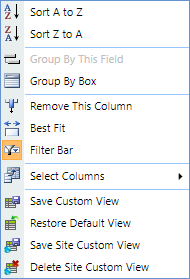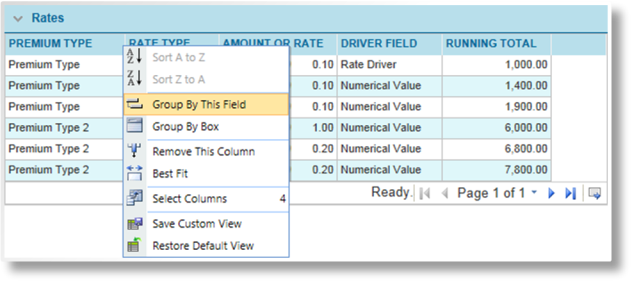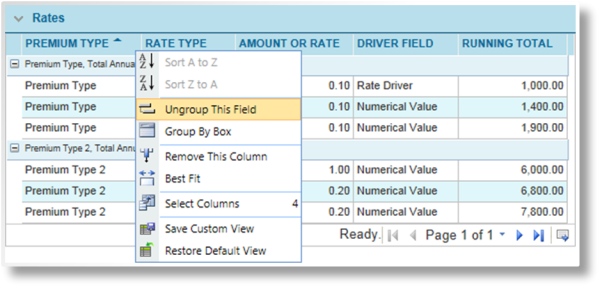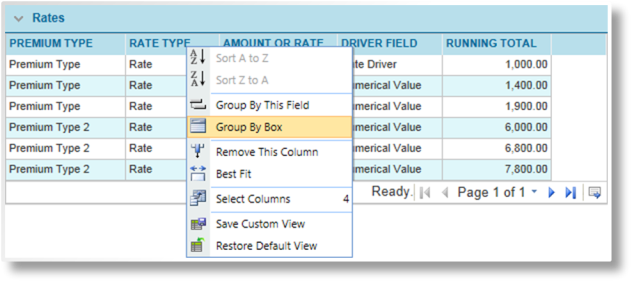Using Grids
In This Topic...
Grids are used throughout the system to present data in a table format. Many grids can be filtered, sorted, and reorganized as needed. Adding or editing data is handled through detail pages that will open as a window or a tabbed set of screens.
Note: Not all features are enabled for all grids.
Organizing Data in Grids
While some grids may only contain a small amount of data, easy to manage on its own, other grids may have multiple pages of detailed information that requires specific control. This is achieved using the advanced filter and sorting options of the grid.
Filtering Grid Data
The filter option  can be used to filter the data in a column, displaying entries that match or do not match a specified option or text.
can be used to filter the data in a column, displaying entries that match or do not match a specified option or text.
Tip: If the filter options are not shown, right click any column header and select Filter Bar from the menu.
- Click the filter icon
 to open the filter menu. The available options depend on the type of data in the column.
to open the filter menu. The available options depend on the type of data in the column.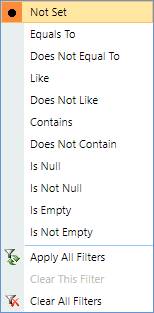
No filter is applied to the column.
For dates and numerical values, displays entries that exceed the filter value.
For dates and numerical values, displays entries that match or exceed the filter value.
For dates and numerical values, displays entries that match or are less than the filter value.
For dates and numerical values, displays entries that are less than the filter value.
Only displays entries that match the filter text exactly.
Only displays entries that do not match the filter text exactly.
Displays all entries that start with the filter text.
Displays all entries that do not start with the filter text.
Displays all entries that contain the filter text.
Displays all entries that do not contain the filter text.
Displays entries that do not include the field being filtered.
Displays entries that include the field being filtered, even if that field is empty.
Displays entries that include the field being filtered, but the field is empty.
Displays entries that contain any value in this column.
If the data has been changed, this option refreshes the filters.
Clears the filter text and sets the filter type to Not Set.
Clears all filter text on the current page and sets all filter types to Not Set.
- Click in the space to the left of the filter icon to enter the filter text. Results are displayed based on the chosen filter type in relation to this text. If no filter has been selected, a default filter is applied, suitable to the type of data in the column. If the column is for dates, then a calendar lookup can be opened using the down arrow icon
 .
.
- Press Enter when the filter text is in place, and the filter is applied.
- The filter text and filter type can be modified as needed to locate the required entries.
Sorting Grid Data
Clicking the header of a column once sorts the data in ascending order, marked by an up arrow  . Clicking the column again sorts by descending order, marked by a down arrow
. Clicking the column again sorts by descending order, marked by a down arrow  . Clicking a third time removes the sorting, restoring the data to its default order.
. Clicking a third time removes the sorting, restoring the data to its default order.
The sorting options can also be reached by right-clicking any column header.
Grouping Grid Data
In addition to sorting, some grids (such as the Rates breakdown in the Quote Report) allow grouping.
| Group By This Field | Create a grouping based on each unique entry in the column. |
| Group By Box | Create a groupings based on a primary grouping displayed under the panel header. |
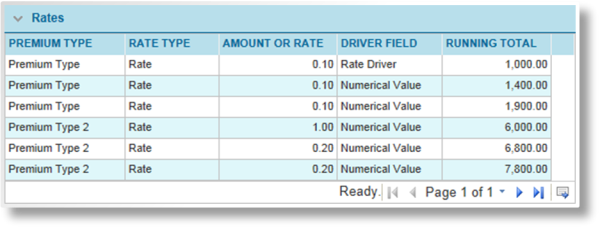
The example above displays a standard grid layout, with data sorted on one column and all entries listed together.
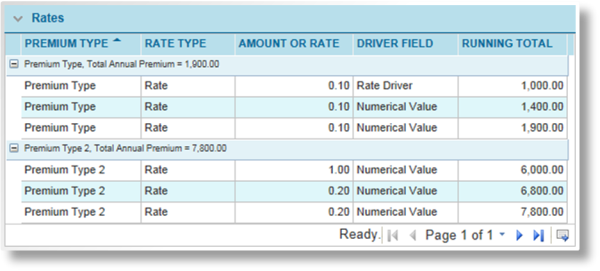
With grouping applied to the Premium Type column, a group is created for each unique entry in that column. All data for each entry is listed together. Sorting can be applied independently of the grouping, and each group can be collapsed or expanded using the  and
and  icons respectively.
icons respectively.
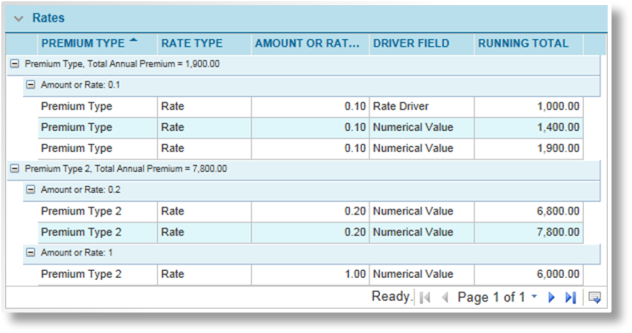
While the first grouping is in place, additional levels of grouping can be applied to other columns. Each column selected for grouping becomes a sub-group of the existing groups.
The most direct way to group by a field is to right-click the header and select Group By This Field. The groups are divided, and additional columns can be added through the same means.
To remove a column from the grid, right-click on the column header and select Ungroup This Field. If there are multiple groupings, they do not need to be removed in order.
In some cases, the grouped column is removed from the grid, preventing it from being removed by this method. Under this condition, the Group By Box should be used (see below).
To activate the Group By Box, right-click any column header and select Group By Box. A space appears between the panel header and the column headers.
Columns can be dragged in and out of this area defining the primary group and any additional groups.
Additional Grid Options
In addition to sorting and grouping, options are available to control the visual display of the grid. These settings can then be saved either for the individual user or all for all users accessing the site.
| Remove This Column | Remove the selected column from the display. |
| Best Fit | Adjusts the width of each column for optimal display. |
| Filter Bar | Controls whether the Filter Bar is displayed under each column header. |
| Select Columns | Add additional columns to the grid display. In order to be available for selection, the column fields must first be added as Custom Columns in the Policy Settings page of the Master Cover. For additional information, see |
| Save Custom View | Save the current custom view as the new individual default view. When selecting this option, the current custom view will persist for subsequent logons. |
| Restore Default View | Restores the default grid display, without any custom formatting that was applied. |
| Save Site Custom View | Save the current custom view for all users accessing the site. This option is only available to users with the appropriate security right. |
| Delete Site Custom View | Delete the current custom view for all users accessing the site. This option is only available to users with the appropriate security right. |
